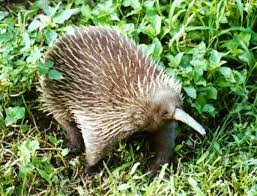Zaglossus attenboroughi : Echidna

An elusive echidna named ‘Zaglossus attenboroughi’, feared extinct after disappearing for six decades, has been rediscovered in a remote part of Indonesia.
- Zaglossus attenboroughi known as Attenborough’s long-beaked echidna (Zaglossus attenboroughi) or Sir David’s Long-beaked Echidna, the animal belongs to a small, unique group of egg-laying mammals called monotremes, which also includes the platypus.
- It is named in honour of naturalist Sir David Attenborough.
- It has never been recorded outside the extremely remote Cyclops Mountains of Indonesia’s Papua region.
- It is the smallest known species of long-beaked echidna, weighing between 5 and 10 kilograms.
- They have five claws on each foot, and adult males have a small, non-venomous spur on the inside of each ankle. Adult females lack these spurs.
- The fur is distinctive, short, fine, and dense, unlike other echidnas, and raw umber brown in color.
- There is short fur that covers the few spines on the middle back of this species.
- Adults have no teeth, but the tongue is covered in tooth-like spikes.
- Conservation Status:
- IUCN Red List: Critically Endangered
Echidnas:
- They are unique, quilled creatures with small eyes and a long nose.
- Similar to hedgehogs, echidnas are spiny, nocturnal creatures that roll into a ball when they sense danger.
- They are shy creatures that live in burrows and only meet others once a year during mating




